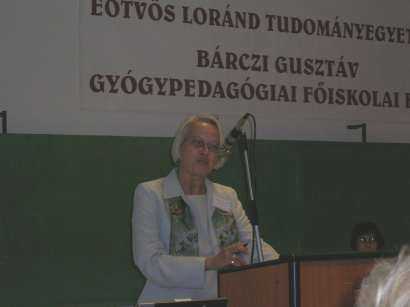Report

| www . ICEVI - Europe . org Report |
 |
[ Previous: Welcome by Beáta Prónay | Table of Contents | Next: ISaR by Emmy Csocsán ]

Dear colleagues, dear friends,
To begin with I would like to welcome all of you to Budapest, the city of our first and our 4th teacher training workshop.
I want to thank all of you who have contributed or will contribute to this workshop. Gina and Bea Pronáy, made all the necessary preparations here in Budapest and took care of all of us even before we came here. Emmy Csocsán, Renate Walthes and their team from the University of Dortmund have been a real asset. They have made preparations with the program, accepted the role as key note speaker and plenary lectures on Isar. The two of them as well as Birgit Drolshagen, Birgit Rothenberg, Frank Laemers, from Dortmund, Krisztina Kovács from Hungary and Tarja Hännikäinen from Finland have accepted the role as chairpersons. We have four reporters from Hungary, Csilla Kelemen, Emese Pajor, Monika Tóth and Lilla Páricsy. My heartfelt thanks to all of you.
To come from Finland and discuss questions regarding education has been a new challenge since the outcomes of the new PISA study has been published. Finland scored between 1 and 4 in all subjects in the OECD assessment study. So, what is it that makes Finland appear "unique" all of a sudden?
I will take some general aspects first and then a highly interesting and relevant point with regard to this ICEVI seminar.
Finland scored highest of all countries in reading literacy performances. The engagement in reading and interest in reading were the major single determinants of the reading performance of Finnish students. The variations in engagement showed 22% in Finland and 13% as an OECD average, Finland had the largest percentage of students borrowing books from the library as well. The difference was that 44% of the Finnish students borrowed books at least once a month, whereas for example the percentage in Hungary was 22%, Germany 18% and Austria 13%. The biggest gender gap in Finland was found within this category. The girls far "outsmarted" the boys in reading. But this was not due to the fact that the Finnish boys were exceptionally bad. On the contrary. They were better than the average OECD. But the Finnish girls outscored everyone and did extremely well.
Another interesting finding was that the socio-economic background did not play the same important role as it does in e.g. Germany. One of the most important reasons for the Finnish success story is the comprehensive school. All children follow the same curriculum in the same school from the age of 7 all through the 9 comprehensive school classes.
The reason why I think that the PISA study can be very well linked to this ICEVI TT workshop is the following statistics on children with special education needs in some of the European countries. I have picked out the available information of the countries participating in the workshop:
| Country | Number of students | % SEN | % segregated |
|---|---|---|---|
| Austria | 848,000 | 3.2 | 1.6 |
| Czech Republic | 1,146,000 | 9.8 | 5.0 |
| Denmark | 670,000 | 11.9 | 1.5 |
| Finland | 584,000 | 17.8 | 3.7 |
| France | 9,709,000 | 3.1 | 2.6 |
| Germany | 9,159,000 | 5.3 | 4.6 |
| Hungary | 1,191,000 | 4.1 | 3.7 |
| Italy | 8,868,000 | 1.5 | <0.5 |
| Norway | 602,000 | 5.6 | 0.5 |
| Poland | 4,410,000 | 3.5 | 2.0 |
| Portugal | 1,366,000 | 5.8 | <0.5 |
| Slovakia | 762,000 | 4.0 | 3.4 |
| Slovenia | 189,000 | 4.7 | 3.4 |
| Spain | 4,541,000 | 3.7 | 0.4 |
| Switzerland | 807,000 | 6.0 | 6.0 |
| UK | 9,994,000 | 3.2 | 1.1 |
As you can see, the difference between the lowest prevalence and the highest is enormous. Italy leads the league of non-impaired children as only 1.5 % of their pupils have special education needs. Finland on the other hand seems to have the absolutely biggest problem in Europe. We lead with a fantastic total of 17.8% children with special education needs.
So, how does that go hand in hand with the PISA study? The reason for the high percentage is, of course, that the Finnish students with for example dyslexia or any other minor need, gets help immediately. He or she is transferred into "special education", that is provisions are made to meet his needs. This way he can remain in his class, study with his peers, and notwithstanding his needs for special education provisions, belong to the top performers in the world. Not bad….
[ Previous: Welcome by Beáta Prónay | Table of Contents | Next: ISaR by Emmy Csocsán ]